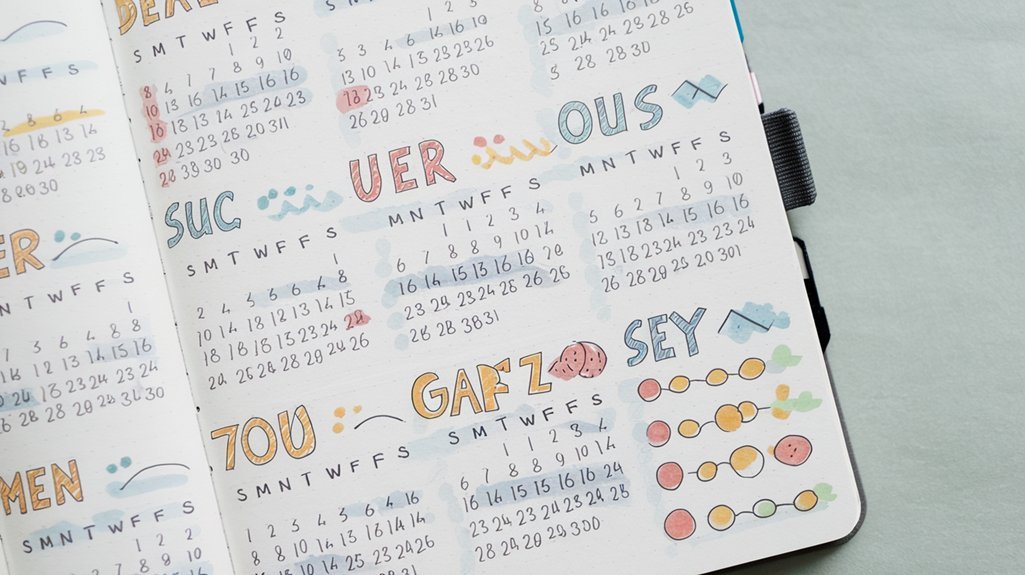You're missing critical insights when you only track sets and reps. Modern progress monitoring includes visual documentation with AI-powered photo analysis that measures muscle symmetry, video movement assessments tracking 23+ body landmarks, and HRV monitoring that reveals recovery status through millisecond heartbeat variations. Energy and mood logging correlates psychological states with performance metrics, while mobility tracking quantifies range-of-motion improvements and identifies compensation patterns. These multidimensional approaches convert raw data into actionable intelligence that basic grids can't capture, revealing the full picture of your training adaptations.
Key Takeaways
- AI-powered video analysis tracks movement quality, joint angles, and exercise form through computer vision algorithms for real-time technique corrections.
- Heart rate variability monitoring assesses recovery readiness by measuring autonomic nervous system balance and predicting optimal training intensity.
- Integrated mood and energy tracking correlates psychological states with physiological metrics to reveal patterns affecting workout performance and recovery.
- Advanced visualization tools identify performance plateaus by linking strength gains, recovery metrics, and injury indicators through multidimensional analysis.
- Range-of-motion measurements and flexibility fingerprinting quantify mobility improvements while identifying compensation patterns and movement asymmetries.
Visual Progress Documentation Through Photos and Videos
While numerical data provides objective metrics, visual documentation remains the most compelling evidence of physical change. You'll find that systematic photo comparisons reveal alterations that scales and measurements can't capture—posture improvements, muscle definition, and body composition shifts become undeniable when you're reviewing side-by-side imagery taken under consistent lighting and angles.
Modern tracking platforms now integrate AI-powered analysis that identifies subtle changes between your progress photos, measuring muscle group development and symmetry ratios. You can utilize standardized photo protocols: identical positioning, weekly intervals, and controlled conditions that eliminate variables.
AI-powered tracking platforms now measure muscle development and symmetry through standardized photo protocols that eliminate variables and reveal subtle physical changes.
Video diaries add vibrant context to your transformation. They're capturing movement quality, range of motion improvements, and exercise form refinement over time.
You're not just documenting aesthetics—you're building a thorough visual dataset that reveals functional progress. Advanced apps now offer frame-by-frame comparison tools and motion tracking overlays, changing casual documentation into actionable performance intelligence.
Biometric and Recovery Data Tracking
Modern fitness trackers capture biometric data that reveals your body's readiness to train and recover.
Heart rate variability (HRV) monitoring measures the millisecond variations between heartbeats, providing a quantifiable indicator of your autonomic nervous system's balance and overall stress levels.
Sleep quality metrics—including REM cycles, deep sleep duration, and nighttime disturbances—offer practical information into whether you're allowing sufficient recovery time between workouts.
Heart Rate Variability Monitoring
Heart rate variability (HRV) measures the millisecond variations between consecutive heartbeats, providing quantifiable data about your autonomic nervous system's balance and recovery status. Advanced fitness trackers now integrate continuous heart rate monitoring with sophisticated variability analysis algorithms, delivering practical insights beyond traditional metrics.
| HRV Metric | Training Application |
|---|---|
| RMSSD | Daily readiness assessment |
| SDNN | Long-term stress evaluation |
| LF/HF Ratio | Autonomic balance tracking |
| Recovery Score | Workout intensity optimization |
| Trend Analysis | Overtraining prevention |
Modern devices capture these measurements during sleep and rest periods, when data accuracy peaks. You'll receive personalized training recommendations based on your HRV trends, enabling precise load management. This technology alters recovery from guesswork into measurable science, optimizing your performance trajectory through evidence-based decision-making.
Sleep Quality Metrics
Because sleep accounts for roughly one-third of your recovery window, fitness trackers now deploy multi-sensor arrays to quantify restorative sleep architecture with clinical-grade precision.
You'll capture practical insights that reshape rest recovery from guesswork into measurable data.
Modern devices dissect sleep quality through:
- REM/Deep Sleep Ratios – Accelerometers and heart rate sensors distinguish light, deep, and REM phases, revealing your restorative sleep percentage versus fragmented periods.
- Blood Oxygen Saturation (SpO2) – Continuous overnight monitoring detects breathing disruptions that compromise recovery quality.
- Sleep Debt Calculations – Algorithms compare your actual sleep duration against physiological baselines, quantifying cumulative deficits that impair performance.
These metrics enable you to correlate training intensity with recovery adequacy, optimizing both workout scheduling and adaptation rates through data-informed rest strategies.
Energy and Mood Correlation Logging
When tracking fitness metrics, energy levels and mood states often reveal patterns that correlate directly with workout intensity, recovery protocols, and nutritional timing. Advanced trackers now integrate mood tracking capabilities alongside physiological data, creating thorough profiles that illuminate performance barriers you've overlooked.
You'll discover that energy patterns fluctuate predictably around training cycles, sleep debt, and macronutrient intake.
Modern platforms employ sentiment analysis through brief daily check-ins, correlating subjective states with objective metrics like HRV, cortisol markers, and glucose levels. This data fusion identifies prime training windows when you're physiologically primed for intensity versus when recovery should dominate.
You'll spot red flags—persistent low mood despite adequate rest signals overtraining or nutritional deficiencies requiring intervention.
The innovation lies in predictive modeling: algorithms forecast energy dips before they occur, prompting preemptive adjustments to training loads or nutrition strategies.
You're not just logging feelings; you're quantifying psychological readiness as a performance variable.
Movement Quality and Form Assessment Tools
Modern fitness trackers now incorporate computer vision algorithms that analyze your movement patterns frame-by-frame, comparing your technique against biomechanical benchmarks stored in their databases.
Video analysis tools like Simi Motion and Hudl Technique capture your workouts at 120-240 fps, while AI-powered platforms such as Tempo and Form Lift provide instant feedback by detecting joint angles and tracking bar paths in real-time.
You'll receive specific cues—like “drive through your heels” or “keep your back neutral”—within milliseconds of deviation, enabling immediate form corrections before compensatory patterns develop.
Video Analysis Technology Options
Video analysis technology has evolved from basic recording tools into sophisticated platforms that assess movement patterns, detect form deviations, and provide real-time biomechanical feedback.
These systems utilize AI-powered pose estimation and computer vision to convert your smartphone into a professional-grade coaching assistant, delivering instant video feedback for technique improvement.
Leading Technology Categories:
- AI Motion Capture Apps – Utilize skeletal tracking algorithms to map 30+ joint positions, generating movement quality scores and personalized correction cues without wearable sensors.
- Cloud-Based Comparison Platforms – Enable side-by-side analysis against expert demonstrations, highlighting angular differences and timing discrepancies in frame-by-frame breakdowns.
- Augmented Reality Overlays – Project biomechanical guidelines and safe movement corridors directly onto live camera feeds, creating interactive training environments with immediate visual reinforcement.
Real-Time Form Correction
As wearable sensors and computer vision merge into unified correction systems, you'll gain access to movement analysis that identifies technical flaws within milliseconds of execution.
These platforms deliver real time feedback through haptic alerts, audio cues, and visual overlays that guide adjustments during active repetitions rather than post-workout reviews.
Advanced algorithms now distinguish between compensatory patterns and intentional variations, enabling precise posture correction without false positives.
Motion capture accuracy has reached sub-degree precision, tracking joint angles across 23+ body landmarks simultaneously.
You'll receive biomechanical scoring that quantifies movement efficiency, comparing your execution against sport-specific standards and elite performance benchmarks.
Integration with resistance equipment creates closed-loop systems where machines automatically adjust loading based on detected form degradation, optimizing safety and training effectiveness.
Habit Streak and Consistency Calendars
Advanced tracking platforms now incorporate:
- Adaptive streak protection that allows one missed day per month without breaking your chain, acknowledging that rigid systems often lead to abandonment.
- Milestone notifications at 7, 30, and 100-day intervals with shareable badges that activate social reinforcement mechanisms.
- Pattern analysis dashboards displaying your most consistent workout days, ideal training times, and correlation between streak length and performance metrics.
These features change simple checkmarks into predictive tools that identify when you're likely to skip sessions, enabling proactive intervention before consistency breaks down.
Performance Pattern Analysis and Trend Mapping
While consistency tracking shows you whether you're working out, performance pattern analysis reveals whether those workouts are actually effective.
Advanced trackers now employ sophisticated data visualization tools that convert raw metrics into practical insights. You'll identify plateaus before they derail your progress accountability, spot correlations between training variables, and recognize when adaptive training adjustments become necessary.
Modern trend identification algorithms detect subtle performance consistency patterns across weeks or months, enabling smarter goal setting based on your actual trajectory rather than wishful thinking.
These feedback loops create motivational strategies grounded in evidence—you're not guessing whether your program works; you're seeing quantified proof.
The most cutting-edge platforms layer multiple data streams simultaneously: strength gains alongside recovery metrics, volume trends against injury indicators.
This multidimensional approach converts scattered workouts into coherent narratives, revealing exactly which training protocols drive results and which waste your time.
Mobility and Flexibility Milestone Recording
Though strength metrics dominate most fitness discussions, mobility benchmarks deliver equally actionable performance data that most tracking systems historically overlooked.
You'll find that documenting flexibility milestones requires precision beyond simple “can touch toes” assessments. Advanced trackers now quantify range-of-motion improvements through comparative video analysis and joint angle measurements.
Modern mobility documentation captures three critical dimensions:
- Pre-workout fluid stretching patterns – Track amplitude increases in leg swings, arm circles, and movement-specific preparations that correlate with injury reduction.
- Foam rolling pressure mapping – Record tissue density changes and trigger point releases through pressure-sensitive integration or manual notation of problem areas.
- Position hold durations – Measure progressive improvements in deep squat holds, overhead reaches, and isometric stretches with timestamp precision.
You're fundamentally building a flexibility fingerprint that reveals compensation patterns and asymmetries before they manifest as injuries.
This data alters subjective “feeling tight” complaints into objective recovery protocols with measurable outcomes.
Narrative Journaling for Mind-Body Connections
Beyond quantitative measurements, your workout journal evolves into a diagnostic tool when you document the psychological states surrounding each training session. Recording pre-workout anxiety, mid-session breakthroughs, and post-exercise clarity creates a narrative structure that reveals patterns between mental states and physical performance.
This creative expression alters standard tracking into emotional release, where you'll identify correlations between stress levels and recovery rates, or motivation fluctuations and strength plateaus.
Advanced practitioners integrate self-reflection techniques that capture sleep quality, interpersonal conflicts, and nutritional choices alongside performance metrics.
The data becomes predictive rather than merely descriptive. You'll recognize that Tuesday's failed lift correlates with Monday's poor sleep, or that morning sessions yield better focus than evening workouts.
This mind-body mapping enables proactive adjustments, turning subjective experiences into actionable intelligence. Your journal becomes a personalized algorithm, decoding how psychological variables influence physical adaptation and training outcomes.
Frequently Asked Questions
How Much Do Advanced Fitness Tracking Apps Typically Cost per Month?
You'll find advanced fitness tracking apps range from $10-$30 monthly for subscription pricing, depending on sophistication level.
Premium platforms offering AI-driven insights, biomechanical analysis, and personalized programming typically command $15-$20.
Elite-tier services with connected hardware integration, real-time coaching, and advanced analytics push toward $30.
When evaluating app features, you're investing in predictive modeling, recovery optimization, and performance forecasting—capabilities that convert raw data into actionable intelligence.
Budget accordingly based on your specific tracking requirements and performance goals.
Can Fitness Trackers Sync Data Across Multiple Devices and Platforms?
Gone are the days of siloed fitness data.
You'll find that modern trackers excel at device synchronization, smoothly connecting your smartphone, tablet, and computer through strong cross-platform compatibility.
Leading platforms like Apple Health, Google Fit, and Strava enable automatic data transfer across iOS, Android, and web interfaces.
You're looking at real-time syncing that updates your metrics within seconds, ensuring your workout history, heart rate trends, and progress analytics remain accessible wherever you train.
What Happens to My Fitness Data if I Cancel My Subscription?
Data retention policies vary considerably across platforms when you cancel subscriptions. Most providers maintain your historical data for 30-90 days, though premium features disappear immediately.
Industry leaders like Garmin preserve lifetime data regardless of subscription status, while others adopt restrictive models. You'll typically lose advanced analytics, custom reports, and cloud storage access.
Before canceling, export your datasets—subscription policies differ greatly, and understanding each platform's specific terms protects your valuable fitness metrics from permanent deletion.
Are Fitness Progress Trackers Compatible With Existing Wearable Devices?
Yes, most modern fitness trackers offer strong wearable integration with popular devices like Apple Watch, Fitbit, and Garmin.
You'll find device compatibility extends beyond basic step counting—expect smooth syncing of heart rate variability, sleep stages, and VO2 max data.
Leading platforms now support 15+ wearable brands through API connections, letting you consolidate metrics into unified dashboards.
This cross-device ecosystem means you're not locked into proprietary hardware, giving you flexibility as technology evolves.
How Do I Back up My Fitness Tracking Data Securely?
Ironically, you're meticulously tracking every rep and calorie, yet your data's probably sitting vulnerable somewhere.
You'll want automatic backups to a secure cloud service with end-to-end data encryption—look for platforms offering AES-256 standards.
Enable two-factor authentication and verify your tracker syncs to HIPAA-compliant or SOC 2-certified providers.
You can also export raw data weekly to encrypted local storage.
Don't let yesterday's security protocols protect tomorrow's biometric insights—your fitness intelligence deserves enterprise-grade protection.
Conclusion
Your fitness journey isn't a single snapshot—it's a vibrant constellation of data points. Each metric becomes a star in your progress galaxy: recovery scores orbit around performance peaks, energy patterns illuminate training windows, and form videos serve as your compass. These advanced trackers convert scattered observations into meaningful patterns, revealing the gravitational pull between effort and adaptation. You're not just collecting numbers; you're mapping the entire ecosystem of your athletic evolution, where every measurement connects to create your personalized performance blueprint.






